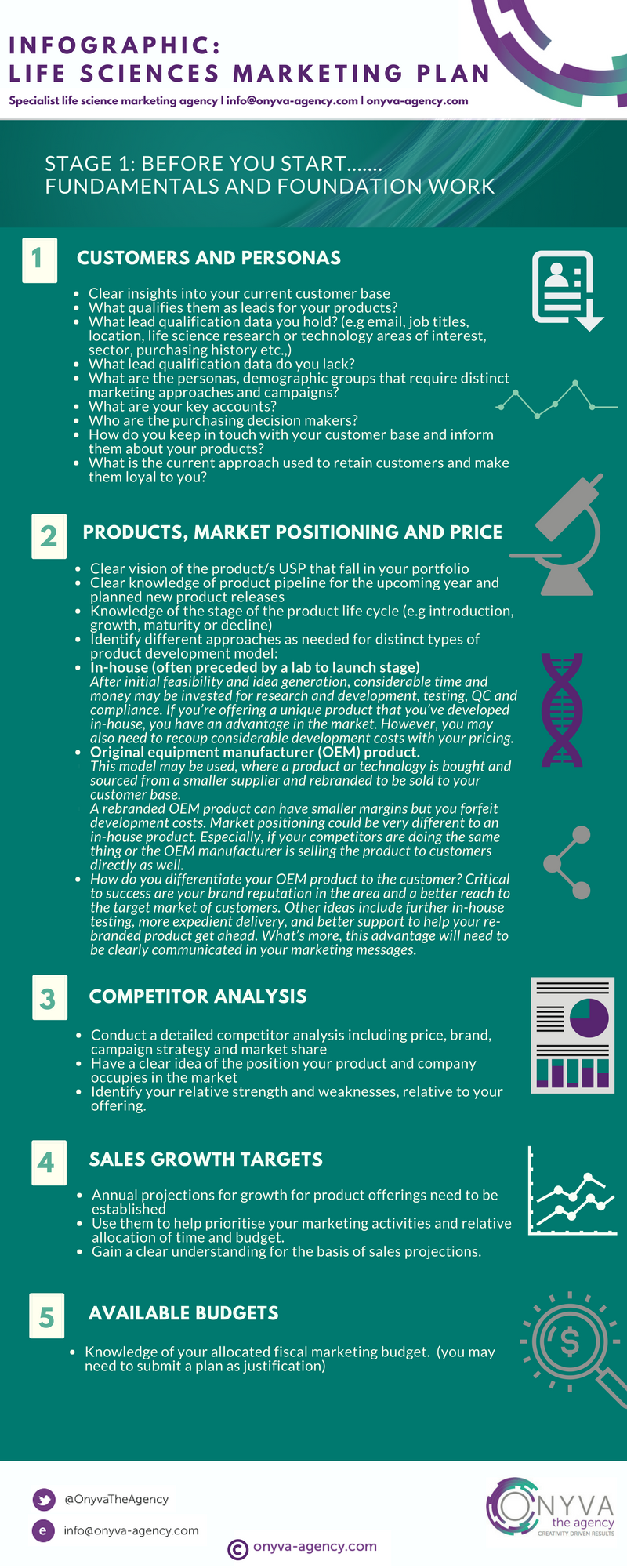Why use a life sciences marketing agency?
If you’re in the early stages of formulating your B2B biotech, or life sciences marketing plan, or alternatively need some pointers to get started, you’ve come to the right place. Working with a life sciences marketing agency (like Onyva) can provide you with added resource due to our extensive experience in the industry and access to relevant tools, which can complement in-house staff and often provide better financial value. In addition, our life science marketing consultants can save you time by helping you implement an effective marketing plan rapidly. We increase your customer base in the life sciences market and nurture them into qualified leads for your product.
Stage 1: Fundamentals and Foundation work
>This article covers key background work that you need to do, before you formulate any effective life sciences marketing strategy. It’s important that you take time to ensure you have these fundamentals in place as a solid foundation to direct you. You will need them on both inbound and outbound aspects of your marketing. Dedicate this time in advance before outlining all the specific plan details, including marketing channels and scheduling.
1a. Customers
You need to have a clear insight into your current customer base, and specifically what qualifies them as leads for your products. Ensure you know what lead qualification data you hold and where the gaps are — e.g email, job titles, location, life science research or technology areas of interest, sector (academia, Pharma etc.,), purchasing history, to name a few. Note that the latter should be captured through active opt-in from subscribers to comply with your country’s data laws. Ask yourself — can you split them into different personas, or demographic groups? Do they need a different marketing approach and campaign? What are there pain points? Who makes the purchasing decision? How do you keep in touch with your customer base and inform them about your products? What is the current approach used to retain customers and make them loyal to you?
1b. Personas
Personas, from a marketing point of view, represent distinct customer groups that require different messaging to convince them to buy or use your product or service. For personas specifically, we recommend preparing a centralised resource that all team members can refer to for customer communication. This ensures all messaging is consistent.
Some examples of life science roles that could require distinct personas depending on your product:
- Academic research: Lab technician; PhD Student; Post doctoral researcher (Postdoc for short); Senior researcher; Assistant Professor; Principal Investigator (or PI)
- Pharmaceutical or biotech companies: Research Scientist; Senior Scientist; Group leader; Team Leader; Director
Data sources for personas:
- Combined knowledge of sales and marketing team. Customer facing team members should have the greatest input and collate knowledge from the conversations and interactions they have with customers
- Your CRM and accompanying data can help you identify trends for the distinct personas your company is dealing with. Also, any data and knowledge gaps you have
- Use a short interview format with any customer interactions, or set up new ones to help collate the relevant data
What information should persona resources include for life science sectors?
This will be different for each use case, but here’s an indicator for B2B life sciences marketing:
Job title (skills, experience); Preferred method of interaction; Challenges they face (relevant to your product); Their goals (relating to your product); What can your product do to help achieve their goals; What problem is your product solving; What objections would they have to our product; What reason would stop them buying; Key marketing message; Key short sales (elevator) pitch.
Store your persona as a centralised PDF or presentation that all the sales and marketing team can access.
2. Products, market positioning and price
Product USP and lifecycle phase
If you’re responsible for a specific product or product portfolio, you need to have a clear vision of the product USP. Which stage of the product life cycle is it at — introduction, growth, maturity or decline? Different approaches are needed for each stage. It’s common for a product that’s developed in-house to be preceded by a lab to launch stage. After initial feasibility and idea generation, it’s common to invest considerable time and money for R&D, testing, QC and compliance. An alternative is the use of an OEM (original equipment manufacturer) model. Here, you opt to buy and source a product or technology from a smaller supplier, and rebrand it to sell to your customer base.
In-house development versus OEM
If you’re offering a unique product that you’ve developed in-house, you have an advantage in the market. However, you may also need to recoup considerable development costs with your pricing.
A rebranded OEM product can have smaller margins, but you forfeit development costs. As a result, market positioning could be very different to an in-house product. Especially, if your competitors are doing the same thing, or the OEM manufacturer is also selling the product directly to customers.
So, how do you differentiate your product to the customer? Critical to success are your brand reputation in the area, and out-manouevering your competitor on customer reach in the target market. Other ideas include further in-house testing, more expedient delivery, and better support to help your re-branded product get ahead. You need to communicate these advantages clearly in your marketing messages.
You should be also be aware of the product pipeline for the upcoming year, including new product releases prior to starting your annual marketing plan.
3. Competitor Analysis
You need to have a clear idea of the position you occupy in the market with your products, before you embark on marketing activities. This also feeds into determining your USP. Hence, a competitor analysis is a fundamental part of your marketing plan. You need to identify your competitors and evaluate their strategies to have a thorough understanding of their strength and weaknesses, relative to your offering.
4. Your sales growth targets
A critical task is to establish annual projections for growth for product offerings to help prioritise your marketing activities. This will help you allocate marketing time and budget effectively as well. Depending on your company structure, this may be the remit of the sales team. It’s important you have a clear understanding for the basis of sales projections. They may be based on year on year growth trends from previous performance — so-called bottom up approach. Alternatively, they can be the result of a company priority designated by the executive board, or the revenue you require to recoup R&D costs of a new product. This will help direct your strategy. The latter two reasons may require more initial time and effort allocation than the former. Especially if your product is already in a sustained growth phase.
5. Available Budgets
You need to have an idea of your allocated fiscal marketing budget. If you have a joint budget pool for your team, it’s common to have to submit a plan as justification for the budget you receive.
In summary
Doing your ground work is essential to provide direction and a solid foundation for your marketing plan. As your first quarter progresses, you may need to modify to account for changes. These could include unseen market factors, a new offering from a competitor for example, and sales performance. Indeed, adaptability is a key skill for marketers who suceed. However, researching thoroughly at the planning stage provides you with clear justification for the strategies adopted.


